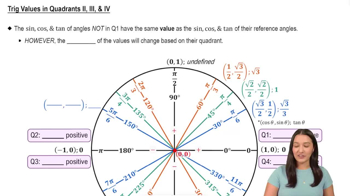Table of contents
- 0. Review of College Algebra4h 43m
- 1. Measuring Angles39m
- 2. Trigonometric Functions on Right Triangles2h 5m
- 3. Unit Circle1h 19m
- 4. Graphing Trigonometric Functions1h 19m
- 5. Inverse Trigonometric Functions and Basic Trigonometric Equations1h 41m
- 6. Trigonometric Identities and More Equations2h 34m
- 7. Non-Right Triangles1h 38m
- 8. Vectors2h 25m
- 9. Polar Equations2h 5m
- 10. Parametric Equations1h 6m
- 11. Graphing Complex Numbers1h 7m
3. Unit Circle
Reference Angles
Problem 1.37
Textbook Question
Find the reference angle for each angle.
205°
 Verified step by step guidance
Verified step by step guidance1
<strong>Step 1:</strong> Understand the concept of a reference angle. A reference angle is the smallest angle that the terminal side of a given angle makes with the x-axis. It is always positive and less than or equal to 90°.
<strong>Step 2:</strong> Determine the quadrant in which the given angle lies. Since 205° is greater than 180° but less than 270°, it lies in the third quadrant.
<strong>Step 3:</strong> In the third quadrant, the reference angle is found by subtracting 180° from the given angle. This is because angles in the third quadrant are measured from the negative x-axis.
<strong>Step 4:</strong> Subtract 180° from 205° to find the reference angle: \( 205° - 180° \).
<strong>Step 5:</strong> The result from the subtraction in Step 4 is the reference angle.
Recommended similar problem, with video answer:
 Verified Solution
Verified SolutionThis video solution was recommended by our tutors as helpful for the problem above
Video duration:
1mPlay a video:
Was this helpful?
Key Concepts
Here are the essential concepts you must grasp in order to answer the question correctly.
Reference Angle
The reference angle is the acute angle formed by the terminal side of a given angle and the x-axis. It is always measured as a positive angle and is used to simplify the calculation of trigonometric functions. For angles greater than 180°, the reference angle is found by subtracting the angle from 360° or 180°, depending on the quadrant in which the angle lies.
Recommended video:

Reference Angles on the Unit Circle
Quadrants of the Unit Circle
The unit circle is divided into four quadrants, each representing a range of angles. The first quadrant (0° to 90°) contains angles where both sine and cosine are positive. The second quadrant (90° to 180°) has positive sine and negative cosine, the third quadrant (180° to 270°) has both negative sine and cosine, and the fourth quadrant (270° to 360°) has positive cosine and negative sine. Understanding these quadrants is essential for determining the reference angle.
Recommended video:

Introduction to the Unit Circle
Angle Measurement
Angles can be measured in degrees or radians, with degrees being the more common unit in basic trigonometry. A full circle is 360°, and angles can be classified as acute (less than 90°), right (90°), obtuse (between 90° and 180°), and reflex (greater than 180°). Knowing how to convert between degrees and radians is important for solving trigonometric problems, especially when dealing with reference angles.
Recommended video:

Reference Angles on the Unit Circle

 5:31m
5:31mWatch next
Master Reference Angles on the Unit Circle with a bite sized video explanation from Callie Rethman
Start learningRelated Videos
Related Practice






















